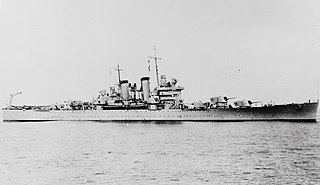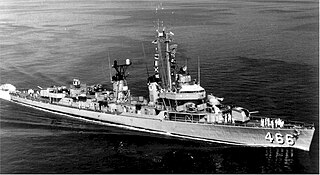
USS Amberjack (SS-219) was a Gato-class submarine, the first United States Navy ship named for the amberjack.

The naval Battle of Kula Gulf took place in the early hours of 6 July 1943 during World War II. The battle involved United States and Japanese ships off the eastern coast of Kolombangara in the Solomon Islands. It took place during the early stages of the New Georgia campaign when a Japanese force landing reinforcements at Vila was intercepted by a force of US Navy cruisers and destroyers. One US light cruiser was sunk during the engagement while two Japanese destroyers were sunk and two more were damaged. The Japanese withdrew after the engagement, having landed 1,600 troops.

USS Helena (CL-50) was a Brooklyn-class light cruiser built for the United States Navy in the late 1930s, the ninth and final member of the class. The Brooklyns were the first modern light cruisers built by the US Navy under the limitations of the London Naval Treaty, and they were intended to counter the Japanese Mogami class; as such, they carried a battery of fifteen 6-inch (150 mm) guns, the same gun armament carried by the Mogamis. Helena and her sister St. Louis were built to a slightly modified design with a unit system of machinery and an improved anti-aircraft battery. Completed in late 1939, Helena spent the first two years of her career in peacetime training that accelerated as tensions between the United States and Japan increased through 1941. She was torpedoed at the attack on Pearl Harbor in December 1941 and was repaired and modernized in early 1942.

The Battle of Vella Gulf was a naval battle of the Pacific campaign of World War II fought on the night of 6–7 August 1943 in Vella Gulf between Vella Lavella Island and Kolombangara Island in the Solomon Islands of the Southwest Pacific.

The Battle off Horaniu was a minor naval battle of the Pacific campaign of World War II, fought near Vella Lavella, in the Solomon Islands. On the night of 17–18 August 1943, four U.S. Navy destroyers intercepted an Imperial Japanese Navy convoy carrying troops to Horaniu, on the northern coast of Vella Lavella, where they were to establish a barge base to support the movement of troops through the region.

USS Nicholas (DD/DDE-449) was a Fletcher-class destroyer of the United States Navy, which served through most of World War II, and for 27 years and two more wars after. She was the second Navy ship to be named for Major Samuel Nicholas.

USS O'Bannon (DD/DDE-450), a Fletcher-class destroyer, was the second ship of the United States Navy to be named for Lieutenant Presley O'Bannon (1784–1850), the Marine Corps's "hero of Derna".

USS Charles Ausburne (DD-570), a Fletcher-class destroyer, was the second ship of the United States Navy to be named for Charles L. Ausburne, a sailor in World War I who was posthumously awarded the Navy Cross.

USS Eaton (DD-510) was a Fletcher-class destroyer in the service of the United States Navy from 1942 to 1946. She was recommissioned from 1951 to 1969 and sunk as a target in 1970.

USS Waller (DD/DDE-466), a Fletcher-class destroyer, was a ship of the United States Navy named for Major General Littleton Waller, USMC (1856–1926).

USS Strong (DD-467), was a Fletcher-class destroyer and the first ship of the United States Navy to be named after Rear Admiral James H. Strong (1814–1882), who rammed the Confederate ironclad CSS Tennessee during the Battle of Mobile Bay, receiving a commendation and promotion to captain.

USS Taylor (DD/DDE-468) was a Fletcher-class destroyer of the United States Navy, named for Rear Admiral William Rogers Taylor (1811–1889). She was laid down on 28 August 1941 at Bath, Maine, by the Bath Iron Works Corp.; launched on 7 June 1942, sponsored by Mrs. H. A. Baldridge; and commissioned on 28 August 1942 at the Charlestown Navy Yard near Boston, Mass., Lieutenant Commander Benjamin Katz in command.

USS Spence (DD-512), a Fletcher class destroyer, was laid down on 18 May 1942 by the Bath Iron Works, Bath, Maine; launched on 27 October 1942; sponsored by Mrs. Eben Learned; and commissioned on 8 January 1943, Lieutenant Commander H. J. Armstrong in command. The ship was named for Robert T. Spence, superintendent of the construction of USS Ontario (1813), and captain of USS Cyane (1815).

USS Cony (DD/DDE-508), a Fletcher-class destroyer, was a ship of the United States Navy named for Joseph S. Cony (1834–1867), a naval officer during the Civil War.

USS Gwin (DD-433), a Gleaves-class destroyer, was the third ship of the United States Navy to be named for Lieutenant Commander William Gwin, an American Civil War officer who commanded river boats against Confederate forces in Alabama.

The second USS Selfridge (DD-357) was a Porter-class destroyer in the United States Navy. She was named for Rear Admiral Thomas O. Selfridge (1804–1902) and his son, Thomas O. Selfridge, Jr. (1836–1924).

USS Farenholt (DD-491) was a Benson-class destroyer in the United States Navy during World War II. She was the second ship named for Admiral Oscar Farenholt.

The Battle of Vella Lavella was a naval battle of the Pacific campaign of World War II fought on the night of 6 October 1943, near the island of Vella Lavella in the Solomon Islands. It marked the end of a three month fight to capture the central Solomon Islands, as part of the Solomon Islands Campaign.
I-39 was an Imperial Japanese Navy B1 type submarine. Completed and commissioned in 1943, she served in World War II, operating in support of Japanese forces in the Battle of Tarawa before she was sunk in November 1943.



















